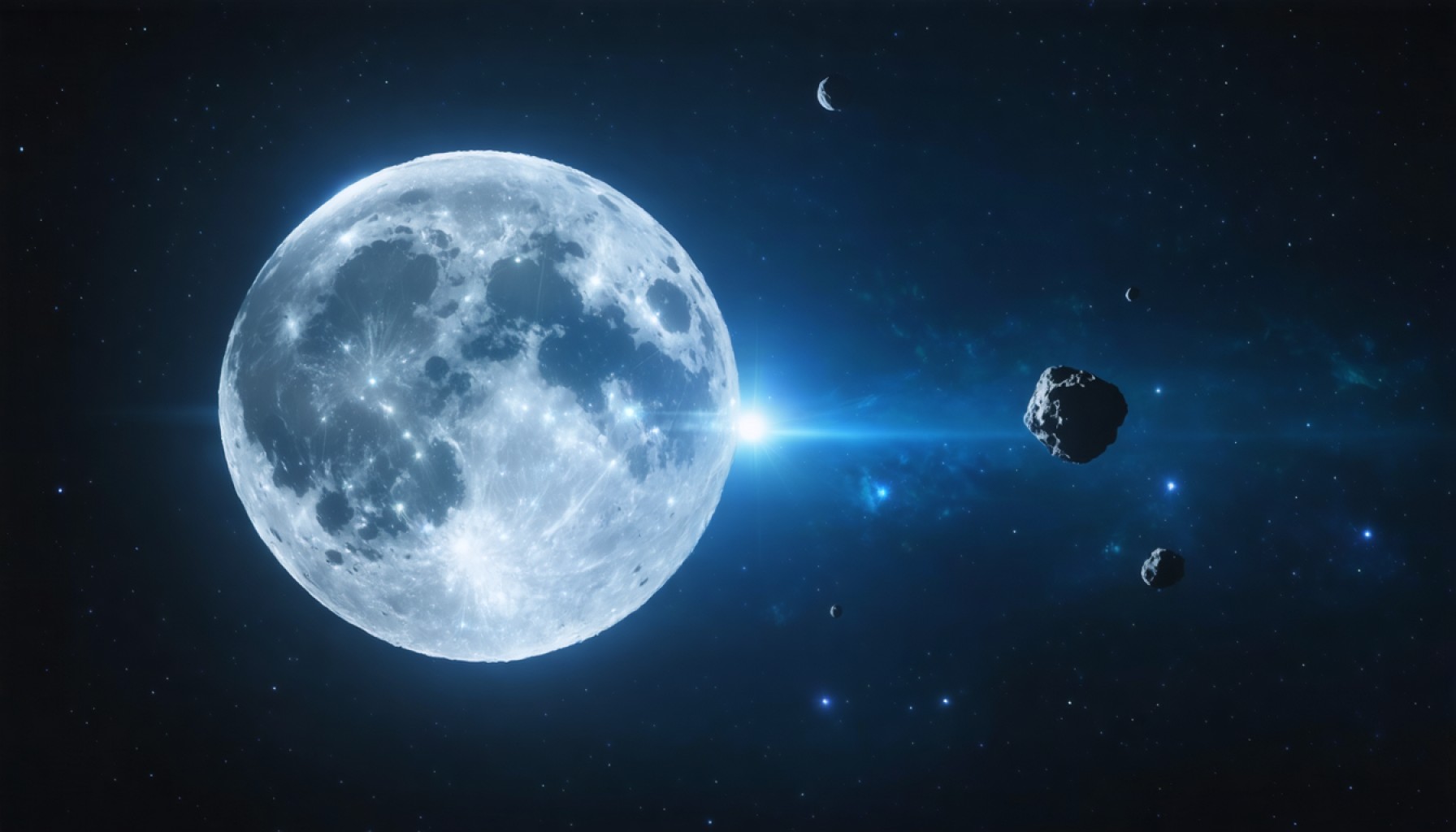- Asteroid 2024 YR4 initially posed a significant threat to Earth with a 3.1% collision probability by 2032, later reduced to 0.28%.
- The latest updates indicate a 1% chance of YR4 impacting the Moon, sparking scientific curiosity.
- Asteroids, remnants from the solar system’s formation, offer invaluable insights into cosmic history.
- Advancements in technology fuel global efforts to monitor and prevent asteroid impacts through initiatives like NASA’s DART mission.
- A potential lunar impact by YR4 could yield unique data that simulations cannot provide, enhancing our understanding of such events.
- The universe constantly reminds us of Earth’s vulnerability, fueling our pursuit of knowledge and preparedness against celestial threats.
Gazing at the cosmic ballet of asteroids, one can’t help but marvel at the dance of fate unfolding above. This week, the world’s attention was caught by a celestial drama as the asteroid, ominously named 2024 YR4, seemed poised to cross paths with our planet. Initially, it presented a chilling 3.1% probability of clashing with Earth by 2032, but relief swept through scientific circles as recent calculations downgraded this threat to a mere 0.28%. Yet, YR4’s journey took an unexpected turn. The latest assessments now suggest a 1% chance of the asteroid impacting the Moon, sparking curiosity more than fear.
For millennia, humanity gazed skyward in ignorance of the rocks whizzing past; it wasn’t until the latter part of the 20th century that serious monitoring of these cosmic wanderers began. Some asteroids—ancient relics from the birth of our solar system—slip unnoticed, while others offer precious insights into the universe’s secrets.
As technology advances, so do our defenses against these wayward travelers. International efforts spearheaded by groups like the Space Mission Planning Advisory Group now strategize not only on response but on active prevention, honing tools akin to NASA’s DART mission to nudge threatening asteroids off-course.
The Moon has become the potential target of YR4, intriguing scientists who see a lunar collision as a priceless opportunity. An impact there could provide data unobtainable by simulations alone, offering a tantalizing glimpse into the dynamics of such cosmic events.
The universe persistently reminds us of Earth’s vulnerability amidst the celestial rubble, a moving testament to our quest for understanding and readiness.
Asteroid Alert: Why 2024 YR4’s Journey to the Moon Captures Global Attention!
Understanding 2024 YR4: A New Chapter in Near-Earth Object Monitoring
The recently spotlighted asteroid, 2024 YR4, initially garnered attention due to its potential Earth impact risk, later receding to a less concerning, yet still astronomically significant 0.28%. Its newfound trajectory toward the Moon brings forth an intriguing opportunity for scientists. But what are the broader implications and practical considerations surrounding such celestial events?
How-To Steps & Life Hacks for Asteroid Monitoring
1. Stay Informed via Reliable Sources: Utilize platforms like NASA’s Near-Earth Object Program or the European Space Agency (ESA) for up-to-date information.
2. Participate in Citizen Science: Engage with initiatives like the International Astronomical Search Collaboration (IASC) to contribute to asteroid detection.
3. Invest in Astronomy Tools: Basic equipment, such as a good telescope, paired with software like Stellarium can help amateur astronomers track asteroids.
Real-World Use Cases of Asteroid Impacts
Asteroid impacts, while rare, have significant scientific value:
– Lunar Collision Studies: If 2024 YR4 impacts the Moon, it could provide insight into impact cratering processes, offering a real-world test of theories derived from simulated data.
– Deflection Strategies: Observing such events aids in refining asteroid deflection technologies, like NASA’s DART mission, essential for future planetary defense.
Market Forecasts & Industry Trends
The increasing interest in space exploration prompts growth in:
– Space-Based Defense Systems: Expect an uptick in investments aimed at technologies to detect and divert potential threats.
– Asteroid Mining Prospects: Though still in infancy, the potential for resource extraction from asteroids is gaining traction, shaping future market dynamics.
Reviews & Comparisons: Asteroid Deflection Technologies
– NASA’s DART vs. ESA’s Hera: DART focuses on kinetic impact, while Hera will follow up with detailed assessments of impact sites, creating a complementary approach to planetary defense.
Controversies & Limitations
– Budget Constraints: Funding remains a critical hurdle in enhancing asteroid detection and deflection capabilities.
– Technological Limits: Current technology struggles with early detection of small or fast-moving asteroids, necessitating rapid advancements.
Features, Specs & Pricing of Asteroid Tracking Tools
– Wide Field Infrared Survey Explorer (WISE): Designed to detect infrared radiation from astronomical bodies, crucial for asteroid identification.
– Atacama Large Millimeter/submillimeter Array (ALMA): Provides high-resolution imagery, albeit at significant operational costs.
Security & Sustainability
– Planetary Defense Protocols: Ongoing development to ensure rapid response remains crucial for long-term planetary sustainability.
Insights & Predictions
– Increased Collaboration: Expect enhanced international collaboration between space agencies to share data and develop unified planetary protection strategies.
Tutorials & Compatibility
Looking for more in-depth tutorials? [NASA](https://www.nasa.gov) offers comprehensive resources and educational materials perfect for budding astronomers.
Pros & Cons Overview of Engaging with Asteroid Events
Pros:
– Enhance scientific understanding of celestial dynamics.
– Spur technological advancements in space exploration.
Cons:
– Potential risk if deflection missions inadvertently alter an asteroid’s path toward Earth.
– High cost and resource commitment required for mission implementation.
Actionable Recommendations
– Join Astronomy Clubs: Leverage local or online groups to discuss and learn more about ongoing asteroid research.
– Advocate for Space Funding: Encourage policymakers to prioritize funding for space research and planetary defense.
Stay informed and engaged; the asteroids may be silent, but the information they carry is potent and profound. For more exploration into space and cosmic defense, check out [Space.com](https://www.space.com).
